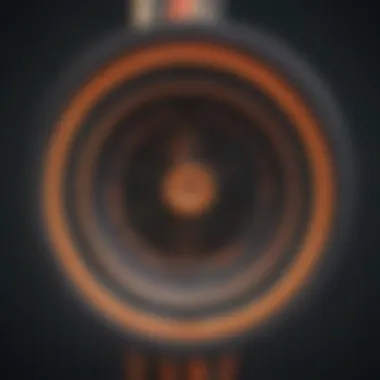Exploring the Importance of Distribution Fiber Optic Cables


Intro
The landscape of communication technology has transformed drastically over the past few decades. Among the key components driving this evolution is the fiber optic cable. It enables high-speed data transfer, which is essential for today’s digital communication demands. This article will dissect the multiple dimensions of distribution fiber optic cables, emphasizing their significance in modern networks. Through a thorough examination of their composition, deployment methods, and the ongoing advancements in technology, readers will develop a clear understanding of their operational efficacy and future potential.
Research Overview
Summary of Key Findings
The research reveals several notable points about fiber optic cables. Firstly, their ability to transmit data at high speeds has rendered them superior to traditional copper cables. Fiber optic cables utilize light signals, which can travel vast distances with minimal loss of quality. Additionally, advancements in manufacturing have led to cables that are more durable and adaptable to various environments. Moreover, the deployment strategies are crucial, as they determine not just efficiency, but also cost-effectiveness in installation.
Importance of the Research in Its Respective Field
Understanding the role of fiber optic cables is essential for professionals in telecommunications and data networking. This research provides insights into why fiber optics is favored over other types of cables. It also highlights the continuous innovations that reshape how networks operate. By examining both the successes and challenges faced in practical deployments, this work paves the way for future research and development.
Methodology
Description of the Analytical Methods Used
The research employed a combination of qualitative and quantitative methods to analyze the effectiveness of fiber optic cables. This involved reviewing existing literature, case studies, and technological reports. The data was gathered from various sources to present a comprehensive view of the topic. Metrics focused on bandwidth, latency, and overall data transmission efficiency were central to the analysis.
Sampling Criteria and Data Collection Techniques
Data was collected from industry reports, government publications, and academic papers. Sampling criteria included various types of fiber optic cables employed in real-world scenarios. By examining different regions and environments, a broad perspective on their performance was achieved. Interviews with experts in the field further enriched the data, providing insights into practical challenges and solutions.
"Fiber optic technology not only aids in achieving better communication but also reduces energy consumption significantly."
Understanding these aspects is vital for engineers, technologists, and decision-makers aiming to implement or improve fiber optic systems in their operations.
Prologue to Fiber Optic Cables
Fiber optic cables are fundamental to modern communication. They enable rapid data transmission, facilitating connectivity across vast distances. This article aims to dissect the critical elements surrounding fiber optic cables, illuminating their structural nuances, technological backdrop, and deployment mechanisms.
Definition and Purpose
Fiber optic cables consist of thin strands of glass or plastic fibers. These fibers carry data as light signals. The core of the fiber is surrounded by a cladding layer, which reflects light back into the core, enabling efficient transmission. The primary purpose of fiber optics is to provide high-speed internet, telephone, and television services. Their ability to transmit large amounts of data over long distances without signal loss is unmatched compared to traditional copper cables.
Historical Development
The journey of fiber optic technology began in the 1960s. Early experiments on light transmission laid the groundwork for practical applications. In the 1970s, scientists successfully created low-loss fibers, making commercial use viable. This innovation spurred a revolution. Fiber optic cables soon replaced copper wires in various communication channels, improving efficiency and speed in telecommunications. By the 1990s, advancements in manufacturing processes led to widespread installation, enhancing global connectivity and sparking an era of data-driven communication.
"Fiber optics marked a significant turning point in the history of telecommunications, allowing for a leap in both speed and efficiency."
In summary, the right understanding of fiber optic cables is essential for appreciating their role in current distribution networks. Their definition and development demonstrate how far this technology has evolved to meet rising communication demands.
Structure of Fiber Optic Cables
The structure of fiber optic cables is fundamental to their function and effectiveness in transmission of data. Understanding the components that make up these cables allows us to appreciate their unique capabilities and advantages over traditional metal wires. Each aspect of the structure plays a critical role, influencing the speed, quality, and distance of signal transmission.
Core and Cladding
Fiber optic cables consist of a core and cladding. The core is the central part of the fiber where light is transmitted. Its diameter can be small, typically ranging from 8 to 62.5 microns, depending on the type of fiber. The cladding surrounds the core and has a lower refractive index, which allows light to be reflected back into the core. This reflects the light and prevents loss of signal, enabling long-distance transmission without degradation. The materials used for the core and cladding are usually silica glass or plastic. The efficient interaction of light within these two layers defines the performance of the fiber optic cable.


Protective Coatings
Protective coatings play a key role in safeguarding the integrity of the fiber optic cables. These coatings serve multiple functions, including protecting against environmental factors such as moisture, temperature changes, and physical damage. Usually made of polymer materials, these coatings also prevent microbending and macrobending that can adversely affect signal quality. Understanding these coatings helps to highlight their significance in ensuring the durability and reliability of fiber optic installations. A well-designed protective layer can greatly enhance the lifespan of the fiber, making it a worthwhile investment in the infrastructure of communication networks.
Cable Types
Fiber optic cables can be categorized into different types, each designed to meet specific needs and applications. The primary types are single-mode fiber, multi-mode fiber, and armored cables.
Single-mode Fiber
Single-mode fiber is designed to carry light directly down the fiber core, which is typically around 8 to 10 microns in diameter. This design allows it to transmit signals over longer distances compared to multi-mode fibers. Its key characteristic is the ability to support high-speed communication without significant attenuation. This makes single-mode fiber an excellent choice for telecommunications and data centers. However, the installation can be more complex, requiring precise alignment and handling, which may lead to higher costs.
Multi-mode Fiber
Multi-mode fiber has a larger core size of about 50 to 62.5 microns, allowing multiple light modes to pass through. This results in higher data transmission speeds over shorter distances, making it ideal for local area networks (LANs). The main advantage is its ease of installation, which can be less costly than single-mode fibers. However, it is not suitable for long-distance communication due to modal dispersion, which can affect signal quality over extended lengths.
Armored Cables
Armored cables are designed to provide additional protection, often featuring a layer of steel or another hard material surrounding the outer sheath of the fiber. This characteristic makes them particularly useful in environments where physical damage may be a concern, such as industrial settings or outdoor installations. The key benefit of armored cables is robust durability. While they tend to cost more than standard cables, their added resistance to damage can prevent costly repairs or downtime, making them a smart investment in high-risk environments.
The structure of fiber optic cables not only defines their performance but also determines their suitability for various applications, from long-distance and high-speed telecommunications to robust industrial networks.
Technology Behind Fiber Optics
Understanding the technology behind fiber optics is crucial. This section explores the foundational principles that enable fiber optic cables to transmit data efficiently over long distances. The sophisticated technology behind fiber optics not only enhances communication systems but also promotes innovation across various industries like telecommunications, medicine, and more. This narrative will illuminate how these technologies benefit users, hinting at their applications in everyday life and broader implications in connectivity.
Light Transmission Principles
The core concept of fiber optics lies in light transmission. Fiber optic cables transmit data in the form of light pulses. This process begins with a light source, which is typically a laser or LED. When light enters the fiber optic cable, it travels through the core, which is surrounded by cladding. The cladding is less dense, allowing the light to bounce off the walls, a phenomenon known as total internal reflection.
This mechanism is vital; it ensures minimal signal loss. Because light can travel significant distances without degradation, fiber optics outperform traditional copper cables. The absence of electrical interference further elevates their reliability. Therefore, fiber optics are crucial for high-quality telecommunications, internet services, and data centers.
Modulation Techniques
Modulation is another key aspect of fiber optics technology. This refers to the methods used to encode information onto light waves. Various techniques exist, each aiming to maximize data integrity and transfer speed. Two primary modulation types include On-Off Keying (OOK) and more complex methods such as Differential Phase Shift Keying (DPSK).
- On-Off Keying (OOK): The easiest method, where information is transmitted by turning the light on or off.
- Differential Phase Shift Keying (DPSK): A more advanced technique, which modulates the phase of the light signal to encode data, leading to improved robustness against noise.
Employing these modulation techniques allows for efficient use of bandwidth, increasing the amount of information transmitted simultaneously. Organizations benefit from faster, more reliable services, enhancing overall productivity.
Fiber optics technology emphasizes clarity and efficiency. Understanding light transmission and modulation enhances the grasp of its crucial role in modern distribution allows individuals to appreciate the broader implications for future technological advancements.
Benefits of Using Fiber Optic Cables
Fiber optic cables represent a fundamental shift in how data is communicated and distributed. They offer several key advantages that are particularly relevant in the current technological landscape. Understanding these benefits is crucial for anyone involved in planning or implementing communication infrastructure.
High Bandwidth Capabilities
Fiber optic cables have a superior capacity for data transmission compared to traditional copper cables. This is largely due to their ability to carry numerous signals simultaneously over a single fiber. They can transmit data at speeds reaching several terabits per second, a feat unattainable with older technology. High bandwidth capabilities enable a vast array of applications, including high-definition video streaming and cloud computing services.
Several factors contribute to this high bandwidth:


- Lower Signal Loss: Unlike copper, fiber optics experience less signal degradation over long distances.
- Multiple Transmission Modes: Fiber technology allows for multiple wavelengths of light to be used for data transmission, which effectively multiplies capacity.
- Future Expansion: As data needs grow, additional fiber strands can be added without overhauling entire systems.
Long Distance Signal Transmission
One notable advantage of fiber optics is their ability to transmit signals over long distances without significant loss of quality. Copper wires, in contrast, gradually lose their ability to carry signals due to electrical resistance and interference. With fiber optics, the use of light as a transmission medium allows for spans of up to 100 kilometers or more without requiring signal boosters. This is crucial for both urban and rural deployment of communication networks.
Furthermore, long-distance signal transmission offers several advantages, including:
- Cost Efficiency: Longer spans reduce the need for repeated signal boosting equipment, ultimately lowering installation and maintenance costs.
- Reliable Connectivity: Businesses and consumers alike benefit from stable connections in remote areas, where other technologies may fail.
Resistance to Interference
Fiber optic cables are inherently more resistant to electrical interference than their copper counterparts. This resistance stems from the fact that the signals carried by fiber optics are light-based. As such, external electromagnetic disturbances have negligible effects on the signal integrity. This resistance results in more reliable data transmission, particularly in environments with high potential for interference, such as factories, hospitals, and urban areas.
Here are some essential aspects of this resistance:
- Signal Clarity: Enhanced clarity enables the transmission of data at higher rates and with minimal errors.
- Safety in Harsh Conditions: Fiber optics are more suitable for deployment in challenging environments, including those with high electromagnetic interference.
The advantages of fiber optic cables make them an ideal choice for modern communication networks, offering solutions that are not only efficient but also secure and reliable.
Deployment Strategies
Deployment strategies for fiber optic cables are crucial in ensuring that these systems function effectively within varying environments. This section evaluates how different approaches can optimize cable performance, enhance network resilience, and reduce costs in diverse scenarios. Understanding these strategies is key for maximizing the advantages that fiber optics bring to modern communication infrastructure.
Urban Distribution Networks
In urban areas, the demand for high-speed internet and connectivity is continuous and growing. Deploying fiber optic cables in urban distribution networks requires careful planning and execution. Here, the existing infrastructure must be assessed to integrate fiber optics successfully. Key considerations include using microtrenching techniques or aerial deployment to minimize disruptions to existing streets and utilities.
- Microtrenching: This method involves cutting narrow trenches to place fiber cables. It is faster and less invasive than traditional digging.
- Aerial installation: For some locations, using poles and existing utilities can be a practical solution. This method cuts costs and installation time.
Given the high population density, ensuring quick access to service becomes essential. Scalability is another advantage of urban networks. When demand increases, additional fibers can be added to existing infrastructure without extensive reworking. Therefore, planning for future expansion is critical in urban deployment.
Rural Connectivity Solutions
Rural areas often present unique challenges for deploying fiber optic cables. The lower population density means a longer distance per subscriber, leading to higher deployment costs. However, the potential for enhanced connectivity in these regions is significant, as fiber can offer reliable service even where traditional copper lines fail.
- Fixed Wireless Access: For some rural deployments, a combination of fiber backhauls to fixed wireless points can serve remote users without needing extensive cabling.
- Grants and Incentives: Many governments provide funding for rural connectivity solutions. Engaging with these programs can lower costs and improve service during deployment.
Strategies for rural fiber deployment must be economically viable while maintaining service quality. Investment in such infrastructure can stimulate economic growth in these regions by enabling better access to online resources and businesses.
Integration with Existing Networks
Integrating fiber optic cables into existing systems is not merely about adding new technology. This requires careful consideration to ensure existing infrastructure can support new capabilities while maintaining stability. Whether integrating into legacy copper lines or existing fiber setups, the process should emphasize minimal disruption to current services.
- Network Upgrades: Existing networks may need upgrades to handle the speed and capacity that fiber optics provide. This might include updating routers or switches.
- Interoperability Issues: Diverse technologies require compatibility checks. Different systems may have varying protocols, necessitating additional equipment or reconfiguration.
A well-planned integration strategy can lead to seamless transitions and improved performance. Understanding these dynamics is vital when looking to future-proof communication capabilities in an increasingly digital world.
"Successful deployment strategies are crucial for maximizing the investment in fiber optic technology across all types of environments."
Challenges in Fiber Optic Cable Distribution


Fiber optic cable distribution plays a critical role in communication networks. However, it is not without its challenges. Understanding these challenges is essential for optimizing networks and ensuring reliable data transmission. In this section, we focus on the key obstacles that engineers and technicians face in the distribution of fiber optic cables. This analysis covers both environmental factors and cost considerations.
Environmental Factors
Environmental conditions significantly influence the performance and longevity of fiber optic cables. Exposure to extreme temperatures, moisture, and UV radiation can degrade cable materials. For instance, direct sunlight can cause the outer jacket to deteriorate over time. This deterioration may lead to potential exposure of the inner fibers to damaging elements.
In addition, geographical challenges also come into play. Areas with rocky terrain may complicate the installation of fiber optic cables. Specialized equipment is often needed to bury cables deeply enough to avoid damage from surface activities. Waterlogged environments pose another threat. Cables require waterproof designs to mitigate risks related to flooding or water intrusion.
Moreover, regulations in different regions can complicate installation processes. Local authorities may have specific requirements regarding digging, below-ground installations, and even aerial placement. Compliance with these regulations is crucial but adds another layer of complexity to deployment.
Cost Considerations
Cost is another pivotal challenge in fiber optic cable distribution. Initial installation costs can be high due to the need for advanced technology and skilled labor. Materials used for fiber optic cables, especially in harsh environments, can be more expensive than traditional copper cables. Furthermore, specialized equipment for installation and maintenance often increases project budgets.
Beyond installation, ongoing maintenance is another financial consideration. Fiber optic networks require regular inspections and periodic upgrades. While these actions ensure optimal performance, they contribute to the overall financial burden of maintaining a fiber optic network.
However, long-term savings can offset these initial costs. Fiber optic cables typically allow for higher bandwidths and longer distances. This capability can reduce the need for multiple connection points, making long-term operational costs lower than traditional mediums.
Ongoing investments in fiber optic infrastructure can lead to sustained network performance and lower costs over time, despite high initial expenditures.
Future Trends in Fiber Optics
The future of fiber optics is critical to understanding the evolution of communication infrastructure. As technology advances, the role of fiber optic cables becomes increasingly central. These cables offer a unique combination of speed and bandwidth, making them the backbone of modern data transmission networks. This section will explore the latest advancements in cable technology and the anticipated growth in the market, providing insight into the trajectory of fiber optics in the coming years.
Advancements in Cable Technology
Advancements in cable technology are making fiber optic systems more efficient and user-friendly. One of the significant developments includes the creation of bend-insensitive fibers. These fibers are designed to maintain performance even when subjected to tight bends and curves, which is crucial in space-limited environments. This innovation reduces the need for extensive support structures, enabling more flexible installations in urban scenarios.
Additionally, new manufacturing processes are emerging, allowing for greater precision in fiber production. For example, advancements in the use of specialty materials contribute to improved durability and performance of cables. Enhanced coating techniques protect fibers from environmental dangers, including moisture and chemicals, increasing their lifespan.
Moreover, active fiber networks, which incorporate optical-electrical signal conversion, are becoming more prevalent. This helps transmit data over longer distances without degrading the signal quality.
These advancements not only improve current infrastructures but also pave the way for innovative applications in smart cities, autonomous vehicles, and high-speed internet services.
Predicted Market Growth
The market for fiber optics is expected to see substantial growth in the coming years. Various research studies suggest that the demand for high-speed internet is driving this expansion. As businesses and households continue to seek faster internet connectivity, the need for new fiber optic installations increases. Reports indicate that the market for fiber optic cables could reach several billion dollars by the end of the decade.
There are several factors contributing to this growth:
- Increased Demand for Data: With the rise of IoT devices and cloud computing, the need for robust data transmission capabilities is greater than ever.
- Telecommunications Upgrades: Many telecommunications companies are shifting toward fiber optic technology to upgrade their existing networks. This transition includes replacing older copper wires with fiber optics to support new technologies like 5G.
- Government Investments: Governments worldwide are investing in improved connectivity infrastructures, often prioritizing fiber optics for their efficiency.
The End
The conclusion of this article highlights the critical importance of understanding fiber optic cables in the context of distribution networks. As technology evolves, these cables serve as the backbone of data transmission, enabling high-speed communication and connectivity.
Summarizing Key Points
In summary, several key points have emerged throughout this exploration:
- Fiber Optic Structure: The anatomy of fiber optic cables includes core and cladding, protective coatings, and various cable types such as single-mode and multi-mode fibers.
- Technological Principles: The principles of light transmission and modulation techniques are fundamental in understanding how data travels through these cables.
- Benefits of Fiber Optics: High bandwidth capabilities, long-distance signal transmission, and resistance to electromagnetic interference position fiber optics as a superior choice in communication technology.
- Deployment: Strategic deployment in urban and rural settings enhances connectivity options while integrating with existing infrastructures remains a priority.
- Forward-Looking Trends: Technology advancements and anticipated market growth signal a robust future for fiber optic applications.
Final Thoughts on Fiber Optics
In closing, the ongoing developments in fiber optic cables reflect a broader trend towards efficient and high-capacity communication systems. Their adaptability to various environments, combined with continual innovation, positions them at the forefront of technological advancements. As society increasingly relies on digital communication, the role of fiber optic cables becomes ever more crucial. Understanding these elements contributes to a deeper appreciation of modern communication networks.
"Fiber optics are not just about speed; they symbolize the future of connectivity in our increasingly digital world."
This comprehensive overview aims to equip students, researchers, educators, and professionals with a nuanced understanding of fiber optic technology and its implications for future communication infrastructures.







